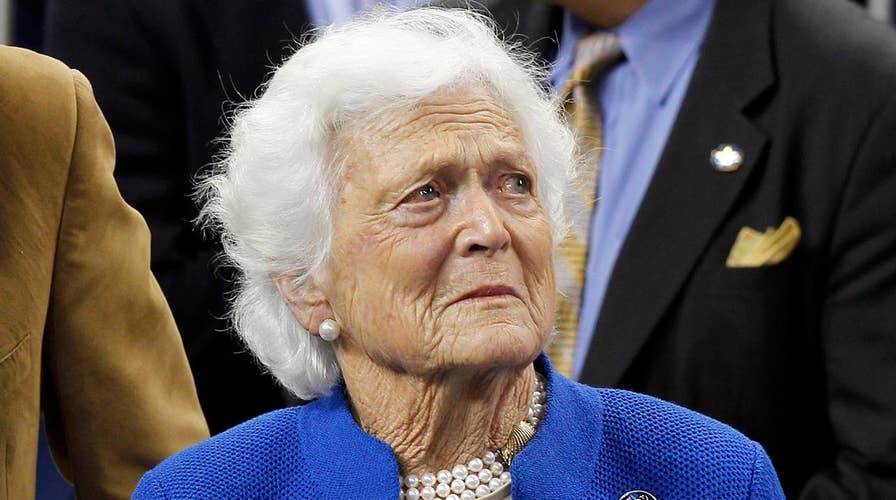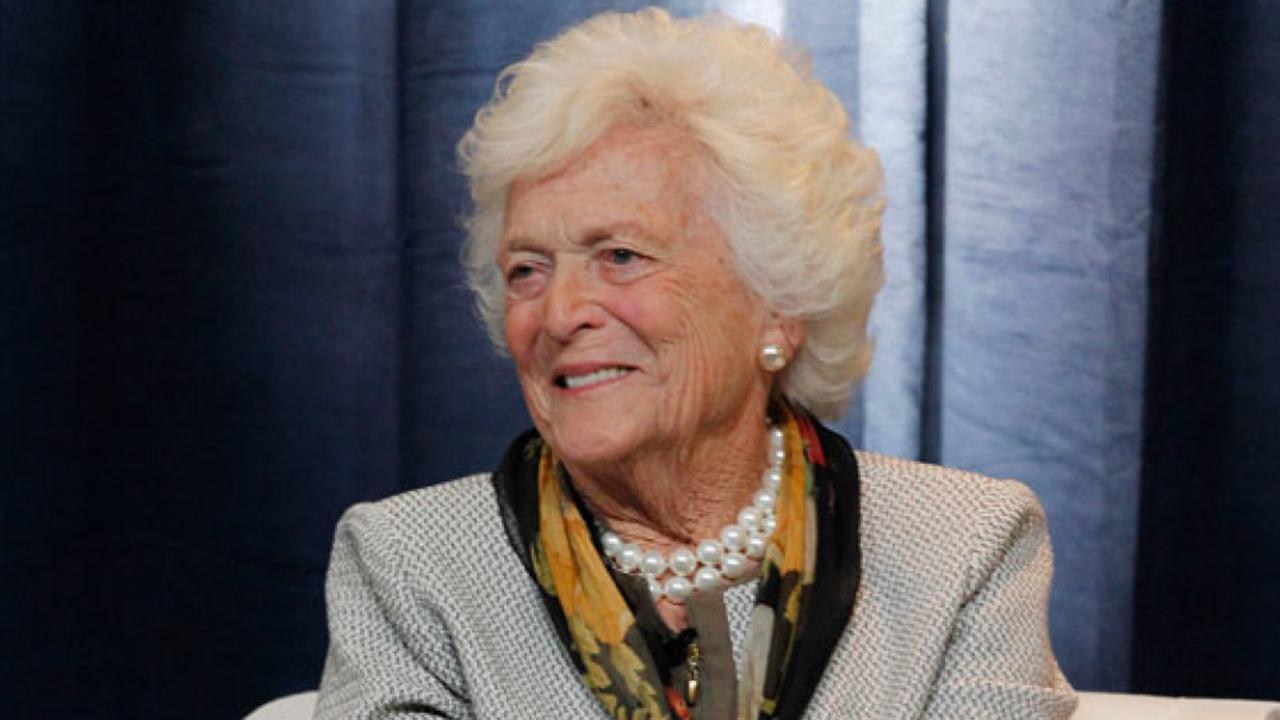Former first lady Barbara Bush in 'comfort care'
Barbara Bush will no longer seek treatment for her failing health after a recent series of hospitalizations; Casey Stegall reports from Texas.
After a series of recent hospitalizations, former first lady Barbara Bush will not seek further medical treatment and will instead focus on comfort care for her failing health, according to a statement released by the family spokesman.
It’s heartbreaking news. The beloved former first lady, now 92, has been the rock of her family – including her husband, former President George H.W. Bush, and son, former President George W. Bush. Mrs. Bush even campaigned for son Jeb Bush during his 2016 presidential run.
As the matriarch of a family with five children, 14 grandchildren and seven great-grandchildren, I have no doubt that Mrs. Bush is surrounded by an abundance of love and support at this time. And according to the statement, her unwavering faith in God is helping her continue to be a “rock in the face of her failing health.”
Mrs. Bush has been treated for decades for a thyroid condition called Graves’ disease, which is an immune system disorder where the organ overproduces hormones. But according to the family, more recent hospitalizations have been for treatment of chronic obstructive pulmonary disease (COPD) and congestive heart failure.
In the wake of this news, many people may be wondering what exactly comfort care is. It’s often thought of in cases of people suffering long battles with cancer and other degenerative diseases, so Mrs. Bush’s brave decision leaves us wondering what comfort care means for the remainder of her life.
I spoke with my friend and colleague, Dr. Lisa Tank, head of geriatric medicine at Hackensack University Medical Center in New Jersey.
Q: What is comfort care?
A: Comfort care is truly a form of care that is very focused on symptom management. It is synonymous with palliative care and when there is a defined time span of less than six months of longevity then it does fall into hospice care. They can be used interchangeably and can be used in different settings: hospital, home and nursing home care.
Being in a hospital – constantly being woken up to get vitals checked, getting blood draws, going for scans in a strange environment – doesn’t provide a patient with a lot of comfort. So if your illness has accelerated and you’re ending up in the hospital, we would take a step back and start to talk about doing things at home for you where you are in your own environment, surrounded by ones you love on your own schedule.
Kudos to Mrs. Bush for saying “this is my goal.” Her goal is to stay at home and enjoy her time with her family. It is very important as far as patient and physician relationships go that the goals are talked about. Goals are very fluid and they reset depending on how the patient is feeling.
What happens in certain chronic diseases like COPD and congestive heart failure is that these are longstanding, and they can decompensate quite quickly, which is when you end up in the emergency room or hospital and the illness is seriously impacting your quality of life.
So with these kinds of diseases, we start to have these conversations early on, so that when we come to a point where a patient’s quality of life is compromised, we have a plan in place.
It’s a very holistic approach. Really a big majority of what we’re doing is educating the caregiver at home on what to look for and what steps to take to make sure the patient is comfortable. That could be playing a patient’s favorite music, having pictures of loved ones around or talking about all the things they have done.
Comfort care interventions are very minimal and not invasive, but they can greatly contribute to a person’s ability to do the things they like to do in spite of their illness.
Q: When would someone typically seek out this kind of care?
A: I think this depends on the disease. People who suffer from chronic conditions are not always thinking of this, we have these conversations with patients and their caregivers when we’re discussing what the trajectory of illness is going to look like.
So patients can seek this care at any point when they feel like their ability to function has decreased – that usually means dressing, bathing, feeding – performing basic daily functions. If we start noticing that our patients are requiring more and more help, it usually sends us a red flag.
A big factor in all this is sleep because when you can’t sleep at night, it makes it really hard to be comfortable.
Q: What kinds of conditions is comfort care most often used for?
A: It’s mainly used for chronic diseases like Mrs. Bush has, or for cancer patients, those with dementia, Parkinson’s, sometimes there is no disease and you are just getting older which is called frailty or failure to thrive. Basically, instead of bringing you to the care we bring the care to you.
Q: What might comfort care look like for Barbara Bush considering her history of COPD and congestive heart failure?
A: With her COPD and congestive heart failure it will most likely be bringing nursing services to the house; some sort of support services to help her with her daily living – basic hygiene, dressing, feeding.
Caregivers may work on modifying her environment, making sure her head is elevated so she can breathe better. There may be treatments for opening her lungs – usually with COPD we use a very low flow of oxygen to help with shortness of breath.
Some patients with COPD struggle with temperature if it’s hot and humid it might make it harder for them to breathe so we would try to keep the temperature cool. Caregivers will also work to alter a congestive heart failure patient’s diet to eliminate salty foods that can cause a buildup of fluid, because it makes breathing tougher. So there are always behavioral things to work on then there’s the pharmaceutical side of it if it’s necessary.
Q: What advice would you give to a family looking into comfort care for a loved one?
A: It’s important to remember that making a decision to seek comfort care does not mean we are withdrawing medical care. This is still a very active medical management plan and more intervention does not necessarily mean you are providing better care. The right intervention at the right time is the best care.
Many times, comfort care tends to get overlooked because a lot of the providers are trained to believe that if they keep doing more, they are providing care to their patients. But sometimes doing less is actually preserving a patient’s quality of life and that’s what we’re here to do.
I think the rest of country joins me in wishing Mrs. Bush our best. Our thoughts and prayers for peace and comfort are with her and the entire Bush family.


